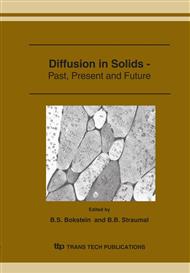p.231
p.235
p.239
p.247
p.255
p.263
p.269
p.275
p.281
Consequences of Silicon Segregation on the Dielectric Properties of Sintered Alumina
Abstract:
The dielectric breakdown strengths of two series of sintered alumina samples of low and high impurity content (where Si is the dominant element with, respectively, 90 and 1500 ppm) and impurity level (25 ppm of Si and 12 ppm of Ti) are compared with positron lifetime measurements. The dielectric breakdown strength of sintered alumina is found higher than that of single crystal. This improvement is stronger when silicon is the only major foreign element. If, in addition to SiO2, MgO and CaO are present in substantial amounts, the improvement is lessened. This is attributed to the enhanced bulk solubility of Si. These results are discussed by calling for the potential traps for positrons and electrons that are located at grain boundaries. It is deduced that the improvement of the dielectric breakdown strength stems from the consequences of Si segregation at grain boundaries via electron trapping in shallow traps, which are likely the x '' Al • Al ) V : (3Si clusters.
Info:
Periodical:
Pages:
281-0
Citation:
Online since:
January 2006
Price:
Сopyright:
© 2006 Trans Tech Publications Ltd. All Rights Reserved
Share:
Citation:


